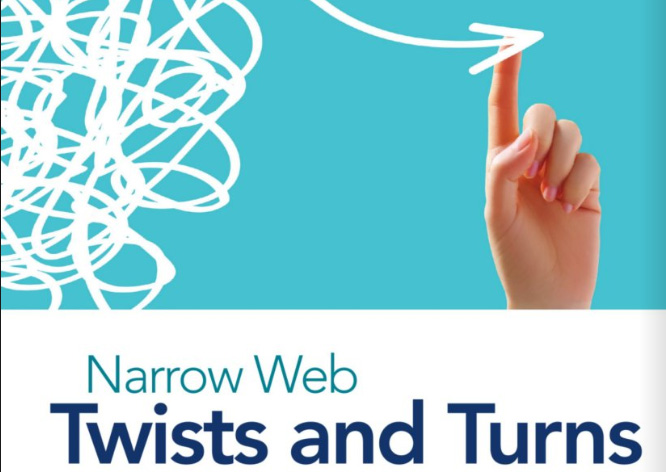Narrow Web Twists and Turns
- Published: January 30, 2020

By Tom Kerchiss, RK Print Coat Instruments Ltd
The ultimate aim of the narrow web converter is essentially the same as it is for their counterparts operating in wide web converting – that is to turn out a product to the highest quality in the minimum of time and at the same time realising a healthy profit. Easier said than done. Overcapacity in traditional markets, customer consolidation, fluctuating currencies, trade wars and political uncertainties, high operating costs, overseas competition and the consequent need on the part of brand owners to find new ways to show off their products remains as ever, a challenge.
The good news though is that the labelling and narrow web converting sector has become more innovative and the use of labels more wide ranging than ever before. But that’s not all. Opportunities abound in shrink labelling, security and electronics, in medical disposables and in sectors such as flexible packaging, particularly the production of pouches, product sampling merchandise and much more. The sophistication and versatility of many of the narrow web presses coming onto the market and the various support and value-added technologies do indeed seem to provide the means whereby the astute and quality focussed converter with the technological edge can thrive.
For many narrow and medium web width converters flexible packaging might add a few twists and turns with regard to the learning curve but narrow web presses are often highly suited for many short run requests. The ability to execute fast changeovers and process a wide range of substrates including combinations of paper, film and foil into an existing process workflow is relatively easy on standard machines. Thinner gauge flexible substrates are highly extensible and demand different approaches to processing and settings.
If a move over to flexible packaging is embarked upon it essential to establish good manufacturing processes and to understand the various characteristics of the materials that are available taking into account substrates, inks, print treatments, coatings and drying or/and UV curing technologies. Partnering with ink, substrate and other key players is essential. So too is having the means whereby quality control can be assessed. Color communication devices such as the FlexiProof can be used for color matching, determining printability, ink/substrate performance over time and for the pre-press trialling of materials and consumables.
Narrow web width machines can be ideal for those orders that are unprofitable for wide web width machines. For instance: where brand owners engage in “try outs,” using a mailing campaign that involves the distribution of product samples, typically small sachets of perfume, hand lotion, shampoo, coffee or tea bags. Generally, these roll outs are regional campaigns and are of low volume. From the brand owner and marketing perspective they can be a relatively low-cost way of assessing how well a product is likely to be received prior to a full-scale national product launch. Sachets or pouches are also used in magazine advertising campaigns, notably by leading cosmetic and perfumery brands in fashion publications. However, their use is not confined to the top end of the market, seed samples are also affixed to gardening publications.
Narrower width machines almost always offer reduced plate and press costs and offer more flexibility than their wider web width counterparts, they use less substrate and less ink during make ready procedures and converting inline is regarded by many as being more efficient as it does not involve multiple setups.
Narrow web focussed companies benefit also from the fact that most manufacturers, especially those operating in the food and drink sectors have widely embraced the concept of lean manufacturing. These organisations want to control inventory costs. For wider web width printing and converting this translates into perhaps more frequent but less profitable orders owing to large minimum repeats and longer changeover times.
Flexible packaging, irrespective of whether its wide or narrow web processed typically involves the use of a combination of materials, each of which has its quirks and peculiarities with regard to handling and processing. Many of the filmic materials run unsupported: web handling and roll dynamics necessitates closed loop and sometimes ultrasonic or a hands-off approach to material handling to avoid issues such gauge band variation and web breaks. Most of the material involved in the production of sample pouches, and label replacement films (an increasingly important area of growth) are thin filmic or combo laminate structures that are engineered to provide specific degrees of barrier resistance or meet other desired requirements.
Products may be surface printed in which case a varnish or laminate overlay is necessary or items may be reverse printed, sometimes referred to as sub surface printing on the backside of the face stock and then laminated. Adhesive, varnish and ink selection must be undertaken with care. For instance: during sub-surface printing the inks will come in contact with the laminate adhesive so they must be compatible. Inks must be carefully balanced with controlled amounts of slip additives to ensure optimum bond. Top coating may be up for consideration to improve ink adhesion and appropriate coatings may be used when UV flexo printing, etc.
When it comes to trialling new materials or developing new products a converter or product developer (ink, adhesive, coating/varnish, substrate manufacturer) may opt to use one of its commercial production machines, however, this generally does not pan out too well. Most production machines possess limited flexibility, they have been built more or less for a set purpose and are restrictive with regard to allowing the operative to experiment. On product trials high levels of waste, downtime, make ready and adjustments in general simply don’t make the use of a production a viable proposition. An important consideration is that a production line machine is taken out of production and is not generating revenue.




